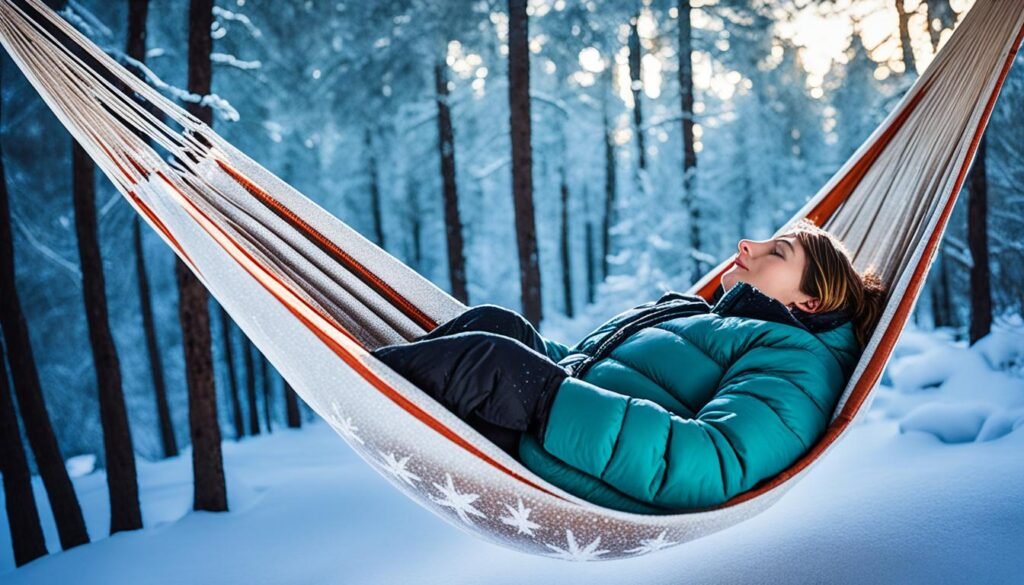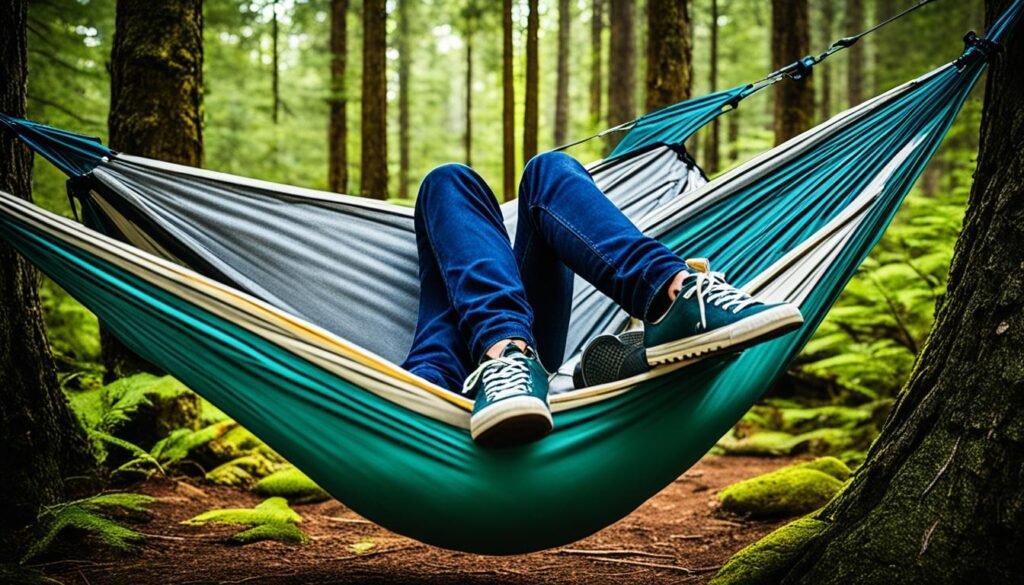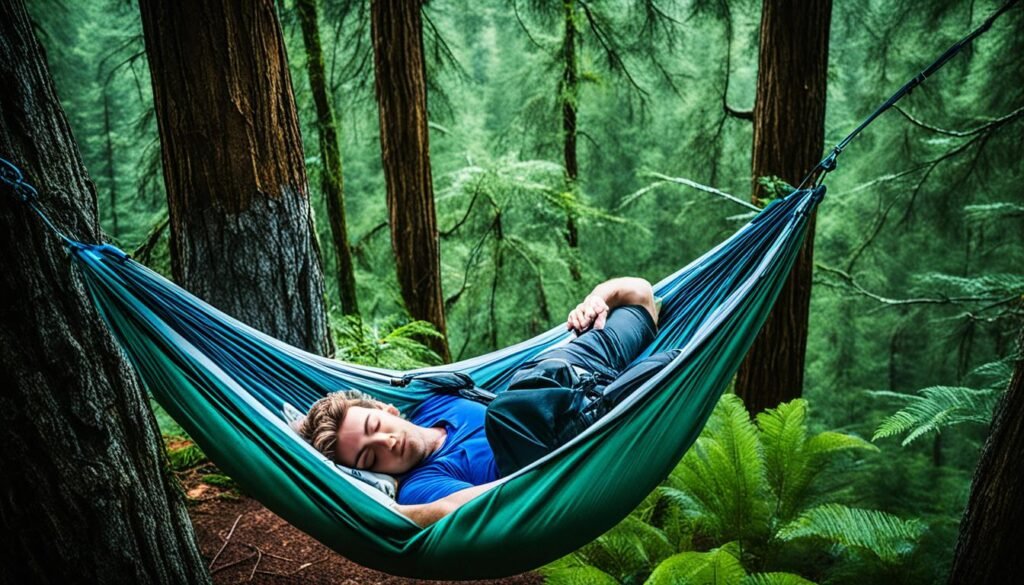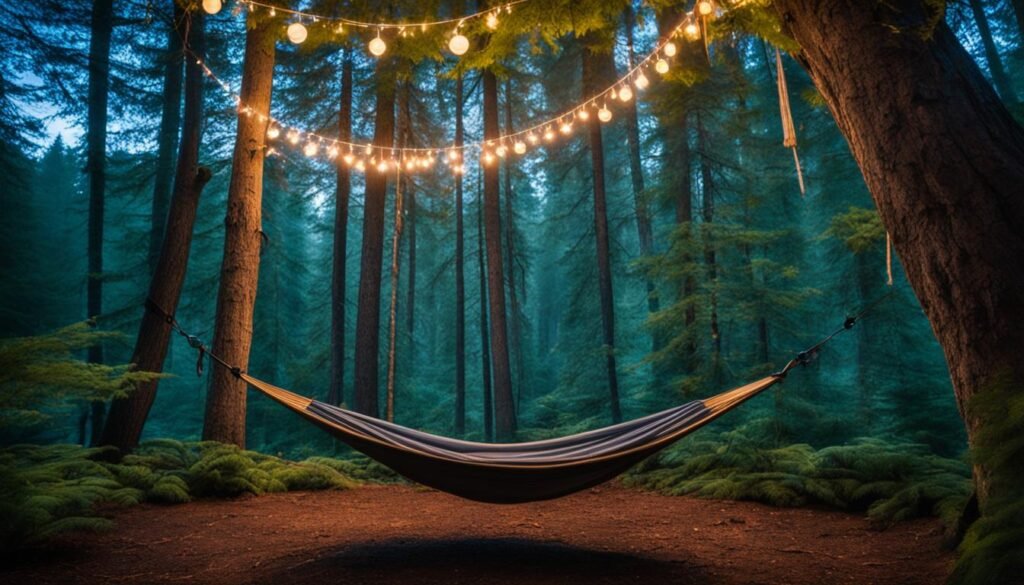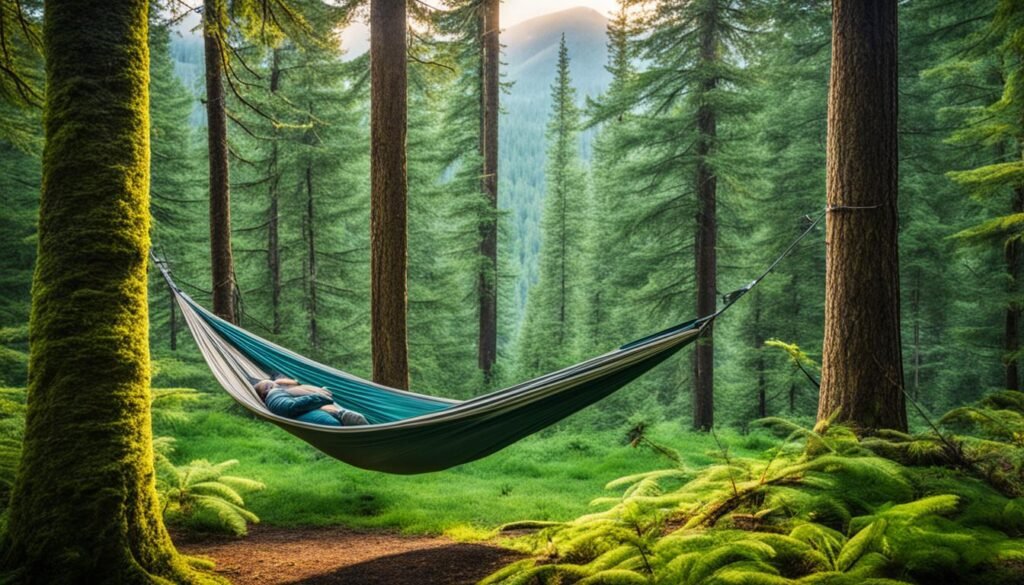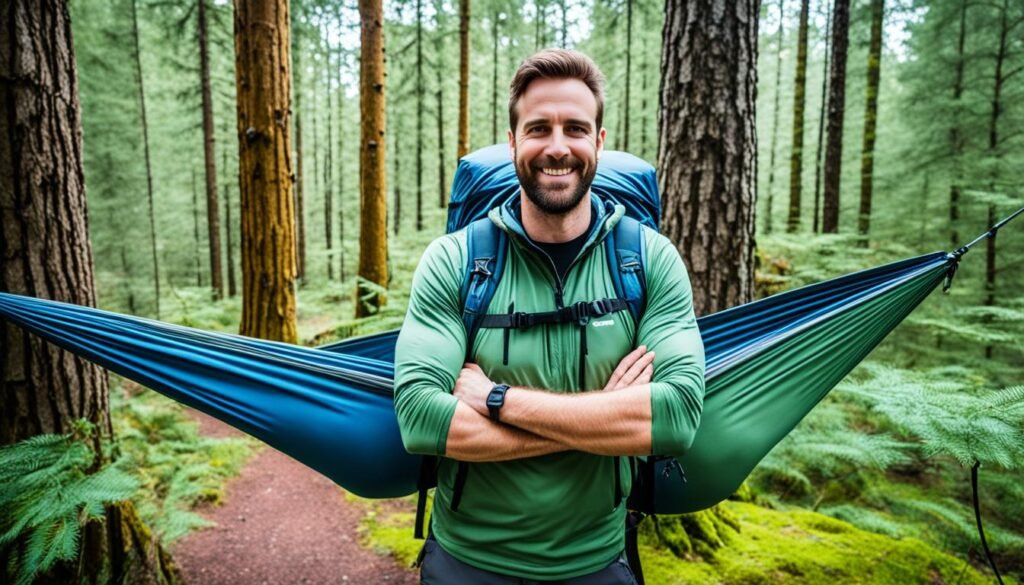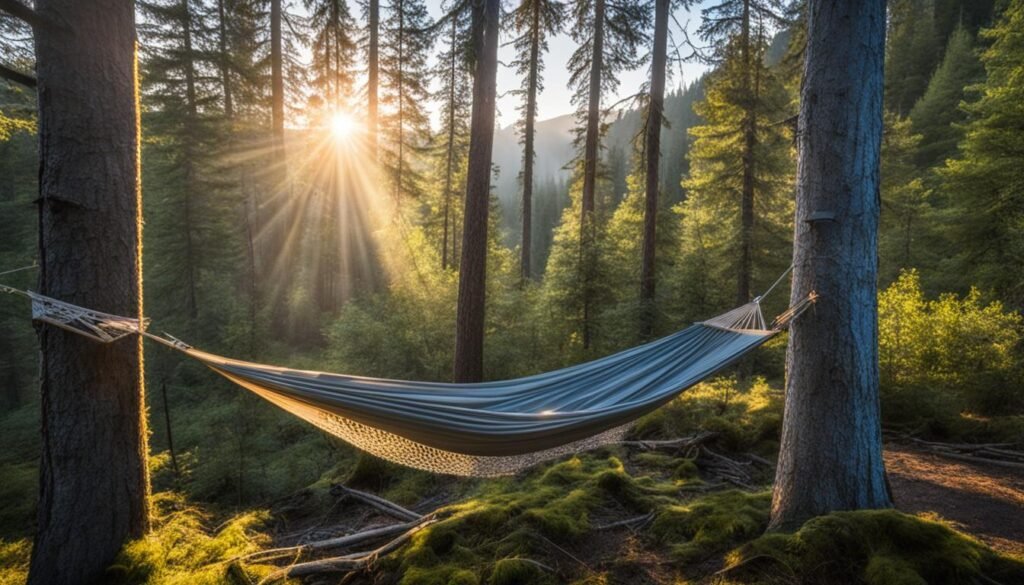Many worry about staying warm in a hammock when it’s cold. It’s doable with the right gear and knowledge. Choices like underquilts, self-inflating mats, CCF pads, and sleeping bags help. Pick what suits your needs.
Key Takeaways:
- Choose the right insulation option for hammock camping in cold weather.
- Consider using underquilts for optimal warmth and wind protection.
- Self-inflating pads/mats offer adjustability and insulation.
- CCF pads are lightweight and durable but may require additional layers for insulation.
- Sleeping bags can provide some insulation when used in combination with other options.
Underquilts: The Preferred Option for Warmth in a Hammock
Underquilts are the top pick for staying warm in a hammock. They are light and block the wind. They come in many shapes and sizes to fit your camping needs.
Insulation:
Underquilts keep you warm by trapping warm air. They stop the cold air from reaching you. This means you sleep cozy all night, even in the cold.
Wind Barrier:
Underquilts also stop the wind. They keep out the cold gusts that can get through the hammock. This makes a warm space inside your hammock, perfect for windy places.
Lightweight:
One big plus of underquilts is they are super light. They’re made to take up little room in your bag. This means you stay warm without carrying a lot of weight.
Warmth:
Underquilts are really warm. They hang under the hammock to stop heat from escaping. This keeps you warm and cozy, even when it’s really cold out.
Underquilts are great for all hammock campers. They keep you warm, block the wind, and are light to carry. They are a must-have for any hammock camping.
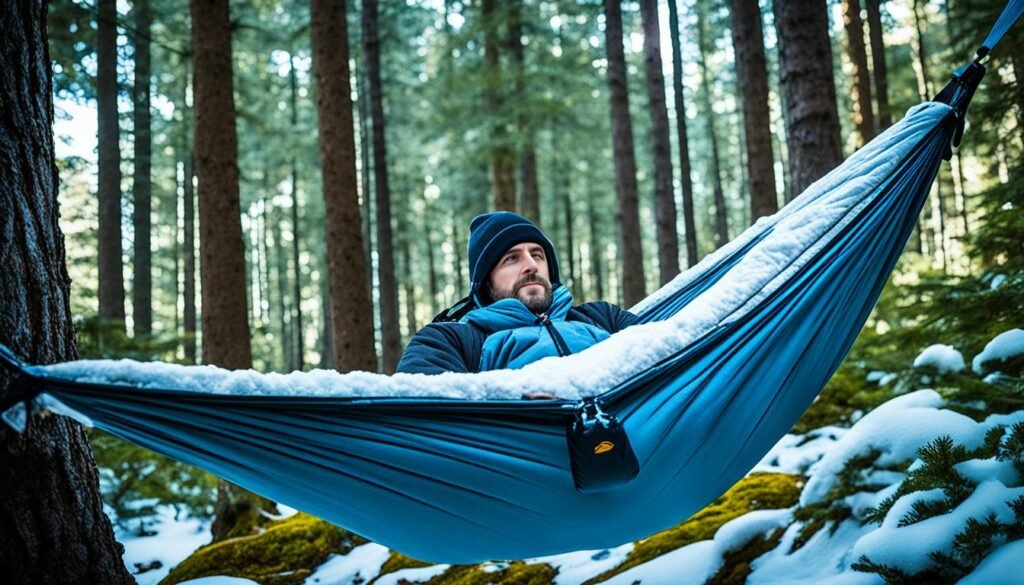
Self-Inflating Pads/Mats: Alternative to Underquilts
Self-inflating pads and mats are great for keeping warm in a hammock. They stop the cold air from reaching you. This means you stay insulated and protected from the wind.
These pads and mats let you adjust their firmness. Whether you like it soft or firm, you can make it just right. This means you’ll always be comfy.
They can be put inside the hammock for warmth. Or between the layers to stop sliding. This flexibility is a big plus.
Different thicknesses and materials are available. So, you can pick what keeps you warmest. No matter how cold it is, there’s a pad or mat for you.
Benefits of Self-Inflating Pads/Mats:
- Efficient insulation against cold air
- Adjustable firmness for personalized comfort
- Wind protection for enhanced warmth
- Versatile placement options inside the hammock
Self-inflating pads and mats make staying warm easy. They insulate, adjust, and protect from wind. Enjoy a comfy sleep in nature.
CCF Pads: Lightweight and Durable Insulation
Staying warm while hammock camping in cold weather is important. A good choice is closed-cell foam (CCF) pads. These pads keep you warm by forming a barrier against the cold air or wind.
CCF pads are both affordable and durable. This makes them great for cold-weather camping. They’re light, so they won’t add much weight to your pack.
CCF pads help keep heat in when used in a hammock. They stop heat from escaping and keep you comfortable. Even though they are thin, they’re warm enough for the whole night.
Some CCF pads might wrinkle or get damp underneath. But, they are still a good choice for warmth. You can use them alone or with other items to stay warmer.
Comparison of CCF Pads With Other Insulation Options
| Insulation Option | Weight | Durability | Insulation Level |
|---|---|---|---|
| CCF Pads | Lightweight | Durable | Adequate |
| Underquilts | Lightweight | Moderate | Excellent |
| Self-Inflating Pads/Mats | Moderate | Moderate | Good |
| Sleeping Bags | Varies | Varies | Varies |
The table shows CCF pads are light and durable for insulation. They’re affordable, reliable, and keep the cold out. They are liked by those who love the outdoors.
Choosing CCF pads means you don’t give up warmth for less weight. Enjoy your time hammock camping.

Sleeping Bags as a Budget Option
Sleeping bags are a great choice for hammock camping in the cold. They are budget-friendly but still offer warmth. They may not be as insulated as other options.
In a hammock, the insulation of a sleeping bag gets squished. This makes it less effective. But, pairing it with things like underquilts or CCF pads can make it cozy.
You can easily find sleeping bags online or in stores. They come in different styles and temperatures. This lets you pick what’s best for your trip and weather.
“Sleeping bags are a versatile option for hammock camping in colder temperatures. Although their insulation may be compromised when used in a hammock, their affordability and accessibility make them a popular choice among budget-conscious campers.”
The Importance of Compression
When picking a sleeping bag for hammock camping, its ability to handle squishing matters. Choose one that keeps warm even when squished. Some are made to stay fluffy and warm in a hammock.
The Insulation Factor
Good insulation is crucial for a sleeping bag. Look for ones with synthetic or down fill. Synthetic is cheaper than down. But quality matters for staying warm.
Add a sleeping bag liner for extra warmth. It helps make up for any warmth lost when the bag is squished in the hammock.
An Affordable Option
Sleeping bags are a budget-friendly choice for staying warm in hammocks during cold weather. They are easy to get and use with other warming gear.
Alone, sleeping bags might not be as warm as underquilts or CCF pads. Yet, they still add comfort and warmth. With the right choice, a sleeping bag is key for your gear.

| Sleeping Bag | Weight | Temperature Rating | Price |
|---|---|---|---|
| Brand A | 2.5 lbs | -10°C | $60 |
| Brand B | 3 lbs | -5°C | $80 |
| Brand C | 2.8 lbs | 0°C | $70 |
Choosing the Right Campsite for Winter Hammock Camping
When camping in cold weather, it’s vital to pick a perfect spot. A good campsite keeps you warm, blocks wind, and gets lots of sunlight. These are key for a cozy time in your winter hammock.
I always look for areas with natural windbreaks, like hills, rocks, or trees. They help block cold winds, making my hammock spot cozier.
It’s smart to think about wind direction when choosing where to camp. Put your hammock where it’s less windy. This keeps you warmer by stopping drafts and wind from cooling you too much.
Finding a sunny spot for your hammock is a good move. If your hammock gets sunlight all day, it helps you stay warm. The sun’s warmth is especially nice in the cold mornings and nights.
Before settling in, look at the trees around you. Avoid trees with weak or low branches. Snow can make these branches dangerous. Safe, strong trees mean a secure spot for your hammock.
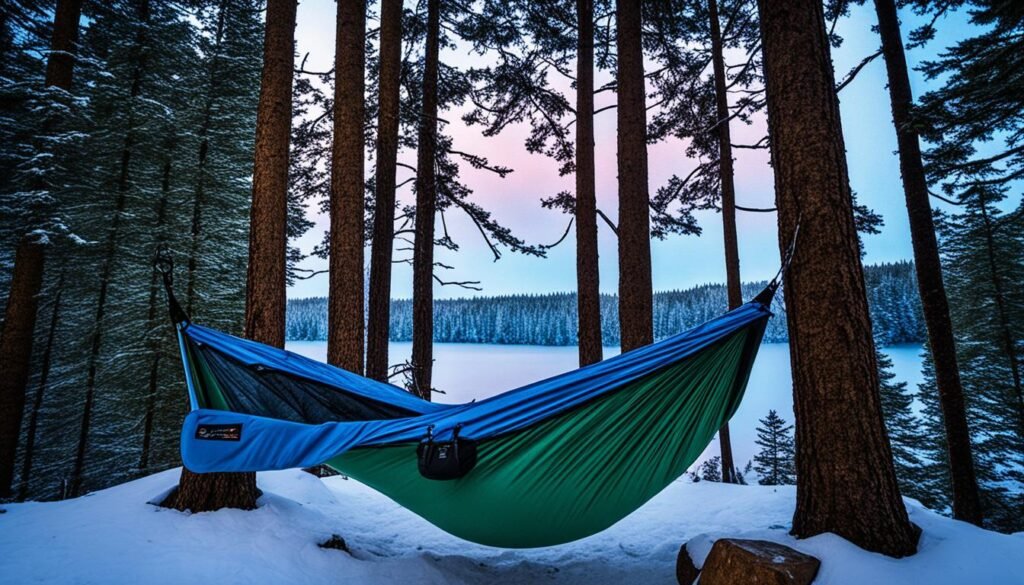
Hammock Campsite Selection Checklist:
- Look for areas with natural windbreaks such as hills, rocks, or trees.
- Consider the direction of the wind and choose a spot that minimizes exposure.
- Choose a campsite that receives ample sunlight throughout the day.
- Inspect trees for weak or low-hanging branches that could pose a hazard when covered in snow.
Keep these tips in mind to pick a great campsite for winter hammock camping. Always aim for places that block wind and catch sun. This will make your camping warm and comfy.
Tips to Stay Warm in a Hammock During Winter Camping
Winter hammock camping can be fun if you stay warm. Here are some ways to keep cozy:
1. Use a Hot Water Bottle for Extra Warmth
A hot water bottle can keep you warm. Fill it with hot water. Put it in your sleeping bag for heat.
2. Change into Dry Clothes Before Getting in the Hammock
Always switch to dry clothes before entering your hammock. Wet clothes can lead to cold and hypothermia. Stay warm and dry for the best sleep.
3. Layer Clothing for Optimal Insulation
Wear layers to trap heat and stay warm. Start with a base layer that wicks moisture away. Then, add insulation like fleece and top with a waterproof layer. This method helps you adjust to changing temperatures.
4. Wear Wool Socks and Winter Accessories
Keep your feet warm with thick wool socks. Don’t forget gloves and a hat too. These items help keep your whole body warm.
5. Keep Extra Clothing Inside the Hammock
Have extra clothes, like a warm hat or another layer, in your hammock. If you feel cold, you can quickly add layers. It’s great to have extra warmth handy.
6. Remove Snow from Clothing Before Getting in the Hammock
Brush off any snow from your clothes before getting in. Snow can melt and make your clothes wet. Dry clothes will keep you warmer.
“Using these tips, you can stay warm and comfortable in your hammock during winter camping.” – Expert Camper
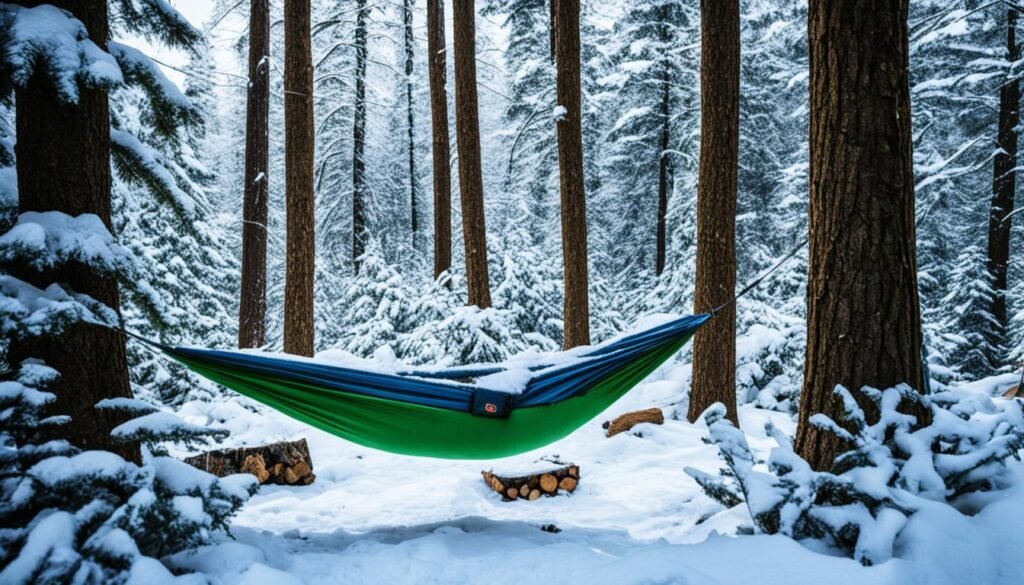
| Tip | Benefits |
|---|---|
| Use a hot water bottle | Extra warmth during the night |
| Change into dry clothes | Prevents dampness and hypothermia |
| Layer clothing | Optimal insulation and temperature regulation |
| Wear wool socks and winter accessories | Keeps feet and extremities warm |
| Keep extra clothing inside the hammock | Convenient access to extra layers |
| Remove snow from clothing | Prevents dampness and discomfort |
Knowing When to End Your Winter Hammock Camping Trip
It’s really important to stay safe while camping in the winter. Knowing when to end your trip can keep you out of trouble.
Feeling too cold or spotting signs of hypothermia or frostbite means you need to act fast. Look for warm shelter and get medical help right away.
Hypothermia happens when your body gets colder faster than it can warm up. This leads to a very low body temperature. Watch out for signs like shivering a lot, a slow heartbeat, slurred words, and feeling very tired. If you see these, get help quickly.
Frostbite is when your body parts get so cold they freeze. This usually happens to your fingers, toes, ears, and nose. Signs include not feeling these parts, seeing blisters, skin color changes, and hurting. Frostbite can be really bad if you don’t take care of it quickly.
Keep an eye on the weather and temperature. It helps to avoid bad surprises with the weather that could make things risky. Always stay updated on any big changes in the weather during your trip.
Your safety is the most important thing when you’re camping in cold weather. Always put your health first. If things don’t feel right or you notice danger signs like hypothermia or frostbite, take action.
Essential Gear for Hammock Camping in Winter
When camping in cold weather, having the right gear is key for warmth and safety. Winter hammock camping requires special equipment. This equipment must handle low temperatures and keep you insulated. Here are three essential items for a better experience:
1. Underquilt
An underquilt is essential for winter hammock camping. It goes under your hammock to trap warm air and block cold. This keeps you warm all night. It shapes to your hammock for complete coverage. Choose underquilts designed for winter, with top-notch insulation and a suitable temperature rating.
2. Top Quilt
A top quilt is also crucial for winter camping in a hammock. It covers you from above, keeping you warm. It provides more freedom than a sleeping bag and keeps heat well. Find a top quilt made from quality materials with a good cold weather rating. Extras like a draft collar and footbox improve comfort and warmth.
3. Winter Tarp
A winter tarp protects your hammock from wind, rain, and snow. It serves as a shield, keeping you dry and safe. Choose a tarp with strong stitching, tough fabric, and adjustable options for setup. Ensure it’s big enough to cover your hammock and gear well.
Getting these essential items – an underquilt, top quilt, and winter tarp – boosts your winter hammock camping. Make sure each piece is high quality and right for the cold you’ll face. With the proper gear, you’ll be warm, comfy, and safe, even in winter weather.
Conclusion
Hammock camping in the cold is fun and fulfilling if you prep right. Choose the right gear like underquilts and sleeping bags to stay warm all night. Picking a good campsite is key too. It should protect you from the wind and catch the sun.
Staying dry in the cold is very important. Change into dry clothes before hopping into your hammock. Keep extra clothes handy inside the hammock to stay warm. Wear layers and don’t forget winter gear like gloves and a hat for extra warmth.
Keep an eye on your body’s temperature. Watch for any signs of getting too cold or frostbite. Knowing when to pack up and seek a warm place is important for your safety. With these tips and the perfect gear, you’re all set for a cozy winter hammock camping trip. Enjoy the beautiful outdoors while snuggled up in your hammock.
FAQ
What options are available to stay warm when hammock camping in cold weather?
Underquilts, self-inflating pads, CCF pads, and sleeping bags all help keep you warm. They provide insulation. Choose any for a cozy sleep.
What is an underquilt and how does it work?
An underquilt is light and keeps you warm. It stops the wind below the hammock. This makes you warm and cozy.
How do self-inflating pads/mats help with staying warm in a hammock?
Self-inflating pads offer warmth. They keep the cold air away. You can adjust them for more comfort.
What are CCF pads and how can they be used for insulation in a hammock?
CCF pads are light and tough. They block the cold air when put in the hammock. They help you stay warm.
Can sleeping bags be used for hammock camping in cold weather?
Sleeping bags help but aren’t the best option alone. They’re better with underquilts or CCF pads. Together, they keep you warm.
How important is choosing the right campsite for staying warm in a hammock during winter camping?
Picking a good campsite is key to warmth. Choose places shielded from wind. A spot in the sun also helps you stay dry and warm.
Do you have any tips for staying warm in a hammock during winter camping?
Sure! Use a hot water bottle for extra warmth. Wear dry clothes and layer up. Don’t forget wool socks and winter add-ons like gloves and a hat.
How do I know when to end my winter hammock camping trip?
Watch out for cold issues like hypothermia or frostbite. Look for shivering, a slow pulse, and numbness. If you see these signs, get warm and seek help right away.
What gear is essential for hammock camping in winter?
You’ll need an underquilt and a top quilt. A winter tarp is also crucial. They all block the cold and keep you warm.
What are some concluding thoughts on hammock camping in cold weather?
With planning and the right stuff, cold-weather hammock camping is fun. Prepare well, stay warm, and enjoy winter’s beauty safely.

